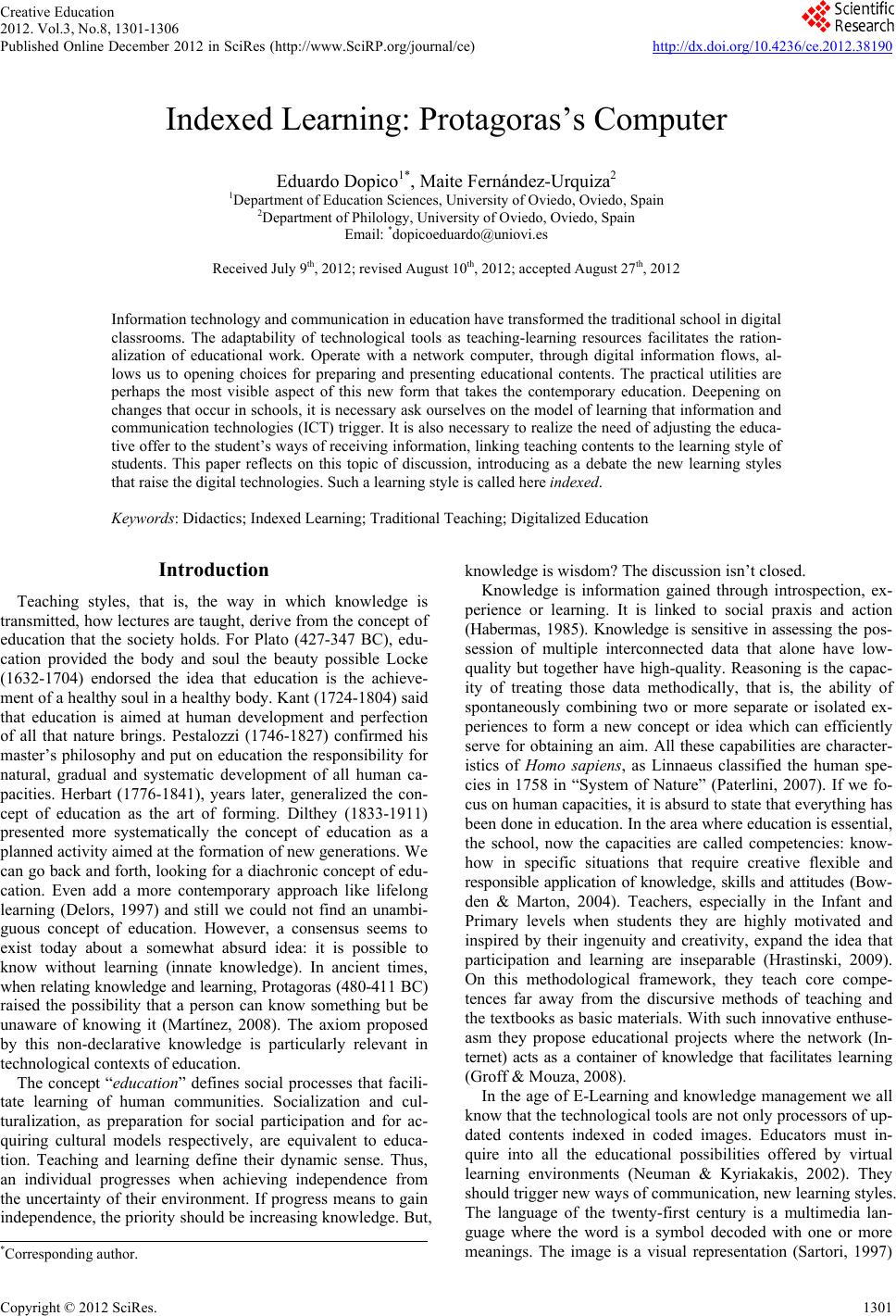 Creative Education 2012. Vol.3, No.8, 1301-1306 Published Online December 2012 in SciRes (http://www.SciRP.org/journal/ce) http://dx.doi.org/10.4236/ce.2012.38190 Copyright © 2012 SciRes. 1301 Indexed Learning: Protagoras’s Computer Eduardo Dopico1*, Maite Fernández-Urquiza2 1Department of Education Sciences, University of Oviedo, Oviedo, Spain 2Department of Philology, University of Oviedo, Oviedo, Spain Email: *dopicoeduardo@uniovi.es Received July 9th, 2012; revised August 10th, 2012; accepted August 27th, 2012 Information technology and communication in education have transformed the traditional school in digital classrooms. The adaptability of technological tools as teaching-learning resources facilitates the ration- alization of educational work. Operate with a network computer, through digital information flows, al- lows us to opening choices for preparing and presenting educational contents. The practical utilities are perhaps the most visible aspect of this new form that takes the contemporary education. Deepening on changes that occur in schools, it is necessary ask ourselves on the model of learning that information and communication technologies (ICT) trigger. It is also necessary to realize the need of adjusting the educa- tive offer to the student’s ways of receiving information, linking teaching contents to the learning style of students. This paper reflects on this topic of discussion, introducing as a debate the new learning styles that raise the digital technologies. Such a learning style is called here indexed. Keywords: Didactics; Indexed Learning; Traditional Teaching; Digitalized Education Introduction Teaching styles, that is, the way in which knowledge is transmitted, how lectures are taught, derive from the concept of education that the society holds. For Plato (427-347 BC), edu- cation provided the body and soul the beauty possible Locke (1632-1704) endorsed the idea that education is the achieve- ment of a healthy soul in a healthy body. Kant (1724-1804) said that education is aimed at human development and perfection of all that nature brings. Pestalozzi (1746-1827) confirmed his master’s philosophy and put on education the responsibility for natural, gradual and systematic development of all human ca- pacities. Herbart (1776-1841), years later, generalized the con- cept of education as the art of forming. Dilthey (1833-1911) presented more systematically the concept of education as a planned activity aimed at the formation of new generations. We can go back and forth, looking for a diachronic concept of edu- cation. Even add a more contemporary approach like lifelong learning (Delors, 1997) and still we could not find an unambi- guous concept of education. However, a consensus seems to exist today about a somewhat absurd idea: it is possible to know without learning (innate knowledge). In ancient times, when relating knowledge and learning, Protagoras (480-411 BC) raised the possibility that a person can know something but be unaware of knowing it (Martínez, 2008). The axiom proposed by this non-declarative knowledge is particularly relevant in technological contexts of education. The concept “education” defines social processes that facili- tate learning of human communities. Socialization and cul- turalization, as preparation for social participation and for ac- quiring cultural models respectively, are equivalent to educa- tion. Teaching and learning define their dynamic sense. Thus, an individual progresses when achieving independence from the uncertainty of their environment. If progress means to gain independence, the priority should be increasing knowledge. But, knowledge is wisdom? The discussion isn’t closed. Knowledge is information gained through introspection, ex- perience or learning. It is linked to social praxis and action (Habermas, 1985). Knowledge is sensitive in assessing the pos- session of multiple interconnected data that alone have low- quality but together have high-quality. Reasoning is the capac- ity of treating those data methodically, that is, the ability of spontaneously combining two or more separate or isolated ex- periences to form a new concept or idea which can efficiently serve for obtaining an aim. All these capabilities are character- istics of Homo sapiens, as Linnaeus classified the human spe- cies in 1758 in “System of Nature” (Paterlini, 2007). If we fo- cus on human capacities, it is absurd to state that everything has been done in education. In the area where education is essential, the school, now the capacities are called competencies: know- how in specific situations that require creative flexible and responsible application of knowledge, skills and attitudes (Bow- den & Marton, 2004). Teachers, especially in the Infant and Primary levels when students they are highly motivated and inspired by their ingenuity and creativity, expand the idea that participation and learning are inseparable (Hrastinski, 2009). On this methodological framework, they teach core compe- tences far away from the discursive methods of teaching and the textbooks as basic materials. With such innovative enthuse- asm they propose educational projects where the network (In- ternet) acts as a container of knowledge that facilitates learning (Groff & Mouza, 2008). In the age of E-Learning and knowledge management we all know that the technological tools are not only processors of up- dated contents indexed in coded images. Educators must in- quire into all the educational possibilities offered by virtual learning environments (Neuman & Kyriakakis, 2002). They should trigger new ways of communication, new learning styles. The language of the twenty-first century is a multimedia lan- guage where the word is a symbol decoded with one or more meanings. The image is a visual representation (Sartori, 1997) *Corresponding author. 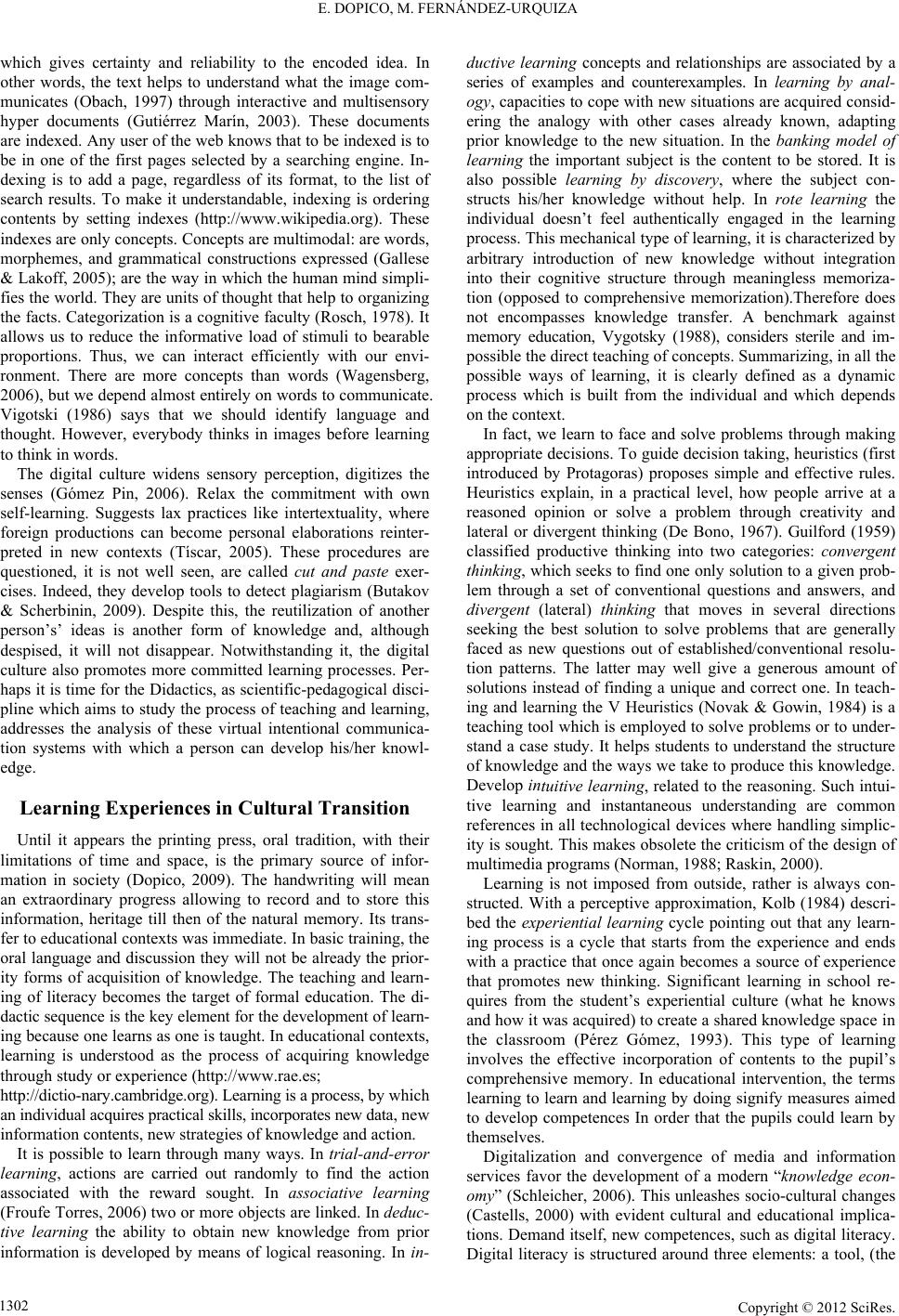 E. DOPICO, M. FERNÁNDEZ-URQUIZA which gives certainty and reliability to the encoded idea. In other words, the text helps to understand what the image com- municates (Obach, 1997) through interactive and multisensory hyper documents (Gutiérrez Marín, 2003). These documents are indexed. Any user of the web knows that to be indexed is to be in one of the first pages selected by a searching engine. In- dexing is to add a page, regardless of its format, to the list of search results. To make it understandable, indexing is ordering contents by setting indexes (http://www.wikipedia.org). These indexes are only concepts. Concepts are multimodal: are words, morphemes, and grammatical constructions expressed (Gallese & Lakoff, 2005); are the way in which the human mind simpli- fies the world. They are units of thought that help to organizing the facts. Categorization is a cognitive faculty (Rosch, 1978). It allows us to reduce the informative load of stimuli to bearable proportions. Thus, we can interact efficiently with our envi- ronment. There are more concepts than words (Wagensberg, 2006), but we depend almost entirely on words to communicate. Vigotski (1986) says that we should identify language and thought. However, everybody thinks in images before learning to think in words. The digital culture widens sensory perception, digitizes the senses (Gómez Pin, 2006). Relax the commitment with own self-learning. Suggests lax practices like intertextuality, where foreign productions can become personal elaborations reinter- preted in new contexts (Tíscar, 2005). These procedures are questioned, it is not well seen, are called cut and paste exer- cises. Indeed, they develop tools to detect plagiarism (Butakov & Scherbinin, 2009). Despite this, the reutilization of another person’s’ ideas is another form of knowledge and, although despised, it will not disappear. Notwithstanding it, the digital culture also promotes more committed learning processes. Per- haps it is time for the Didactics, as scientific-pedagogical disci- pline which aims to study the process of teaching and learning, addresses the analysis of these virtual intentional communica- tion systems with which a person can develop his/her knowl- edge. Learning Experiences in Cultural Transition Until it appears the printing press, oral tradition, with their limitations of time and space, is the primary source of infor- mation in society (Dopico, 2009). The handwriting will mean an extraordinary progress allowing to record and to store this information, heritage till then of the natural memory. Its trans- fer to educational contexts was immediate. In basic training, the oral language and discussion they will not be already the prior- ity forms of acquisition of knowledge. The teaching and learn- ing of literacy becomes the target of formal education. The di- dactic sequence is the key element for the development of learn- ing because one learns as one is taught. In educational contexts, learning is understood as the process of acquiring knowledge through study or experience (http://www.rae.es; http://dictio-nary.cambridge.org). Learning is a process, by which an individual acquires practical skills, incorporates new data, new information contents, new strategies of knowledge and action. It is possible to learn through many ways. In trial-and-error learning, actions are carried out randomly to find the action associated with the reward sought. In associative learning (Froufe Torres, 2006) two or more objects are linked. In deduc- tive learning the ability to obtain new knowledge from prior information is developed by means of logical reasoning. In in- ductive learning concepts and relationships are associated by a series of examples and counterexamples. In learning by anal- ogy, capacities to cope with new situations are acquired consid- ering the analogy with other cases already known, adapting prior knowledge to the new situation. In the banking model of learning the important subject is the content to be stored. It is also possible learning by discov ery , where the subject con- structs his/her knowledge without help. In rote learning the individual doesn’t feel authentically engaged in the learning process. This mechanical type of learning, it is characterized by arbitrary introduction of new knowledge without integration into their cognitive structure through meaningless memoriza- tion (opposed to comprehensive memorization).Therefore does not encompasses knowledge transfer. A benchmark against memory education, Vygotsky (1988), considers sterile and im- possible the direct teaching of concepts. Summarizing, in all the possible ways of learning, it is clearly defined as a dynamic process which is built from the individual and which depends on the context. In fact, we learn to face and solve problems through making appropriate decisions. To guide decision taking, heuristics (first introduced by Protagoras) proposes simple and effective rules. Heuristics explain, in a practical level, how people arrive at a reasoned opinion or solve a problem through creativity and lateral or divergent thinking (De Bono, 1967). Guilford (1959) classified productive thinking into two categories: convergent thinking, which seeks to find one only solution to a given prob- lem through a set of conventional questions and answers, and divergent (lateral) thinking that moves in several directions seeking the best solution to solve problems that are generally faced as new questions out of established/conventional resolu- tion patterns. The latter may well give a generous amount of solutions instead of finding a unique and correct one. In teach- ing and learning the V Heuristics (Novak & Gowin, 1984) is a teaching tool which is employed to solve problems or to under- stand a case study. It helps students to understand the structure of knowledge and the ways we take to produce this knowledge. Develop intuitive learning, related to the reasoning. Such intui- tive learning and instantaneous understanding are common references in all technological devices where handling simplic- ity is sought. This makes obsolete the criticism of the design of multimedia programs (Norman, 1988; Raskin, 2000). Learning is not imposed from outside, rather is always con- structed. With a perceptive approximation, Kolb (1984) descri- bed the experiential learning cycle pointing out that any learn- ing process is a cycle that starts from the experience and ends with a practice that once again becomes a source of experience that promotes new thinking. Significant learning in school re- quires from the student’s experiential culture (what he knows and how it was acquired) to create a shared knowledge space in the classroom (Pérez Gómez, 1993). This type of learning involves the effective incorporation of contents to the pupil’s comprehensive memory. In educational intervention, the terms learning to learn and learning by doing signify measures aimed to develop competences In order that the pupils could learn by themselves. Digitalization and convergence of media and information services favor the development of a modern “knowledge econ- omy” (Schleicher, 2006). This unleashes socio-cultural changes (Castells, 2000) with evident cultural and educational implica- tions. Demand itself, new competences, such as digital literacy. Digital literacy is structured around three elements: a tool, (the Copyright © 2012 SciRes. 1302 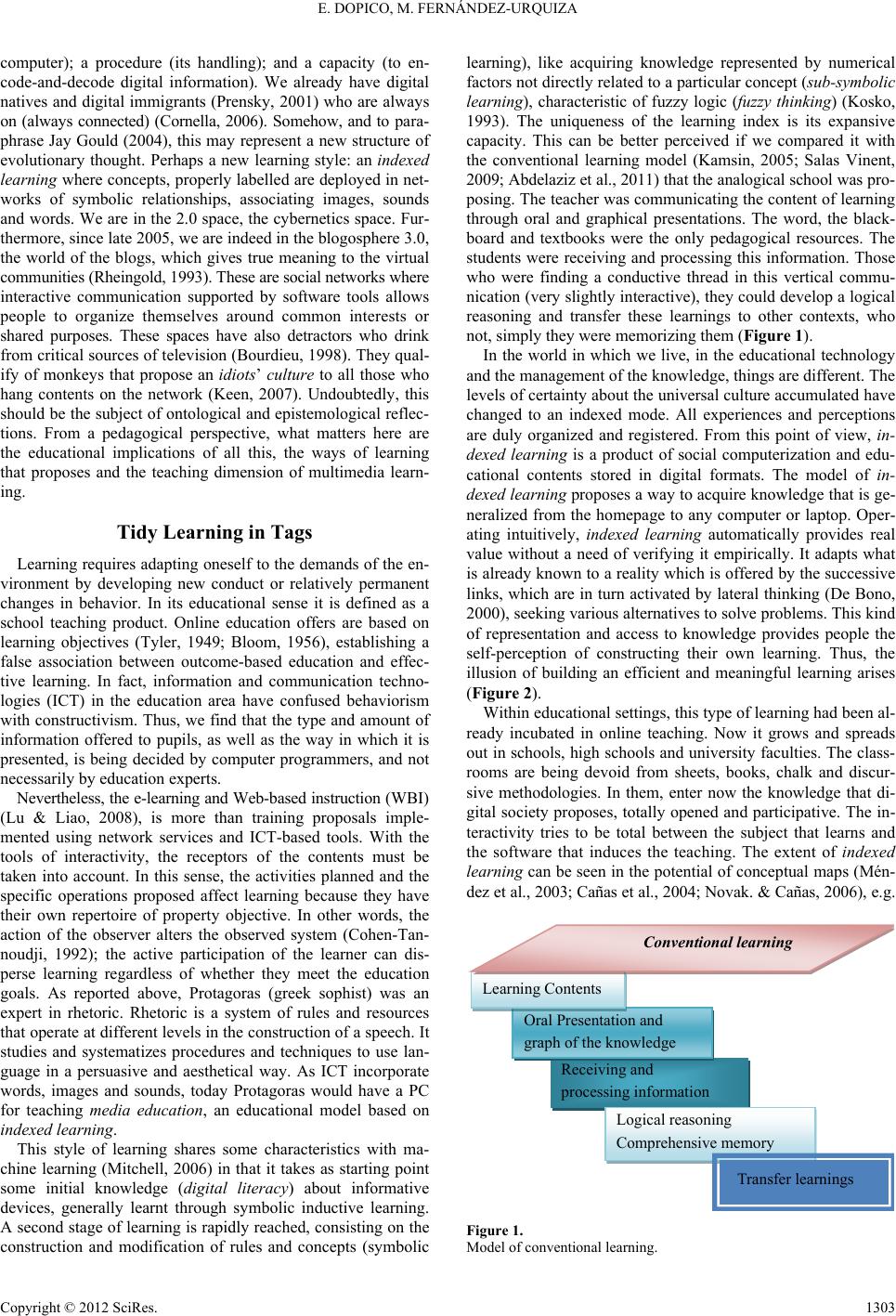 E. DOPICO, M. FERNÁNDEZ-URQUIZA computer); a procedure (its handling); and a capacity (to en- code-and-decode digital information). We already have digital natives and digital immigrants (Prensky, 2001) who are always on (always connected) (Cornella, 2006). Somehow, and to para- phrase Jay Gould (2004), this may represent a new structure of evolutionary thought. Perhaps a new learning style: an indexed learning where concepts, properly labelled are deployed in net- works of symbolic relationships, associating images, sounds and words. We are in the 2.0 space, the cybernetics space. Fur- thermore, since late 2005, we are indeed in the blogosphere 3.0, the world of the blogs, which gives true meaning to the virtual communities (Rheingold, 1993). These are social networks where interactive communication supported by software tools allows people to organize themselves around common interests or shared purposes. These spaces have also detractors who drink from critical sources of television (Bourdieu, 1998). They qual- ify of monkeys that propose an idiots’ culture to all those who hang contents on the network (Keen, 2007). Undoubtedly, this should be the subject of ontological and epistemological reflec- tions. From a pedagogical perspective, what matters here are the educational implications of all this, the ways of learning that proposes and the teaching dimension of multimedia learn- ing. Tidy Learning in Tags Learning requires adapting oneself to the demands of the en- vironment by developing new conduct or relatively permanent changes in behavior. In its educational sense it is defined as a school teaching product. Online education offers are based on learning objectives (Tyler, 1949; Bloom, 1956), establishing a false association between outcome-based education and effec- tive learning. In fact, information and communication techno- logies (ICT) in the education area have confused behaviorism with constructivism. Thus, we find that the type and amount of information offered to pupils, as well as the way in which it is presented, is being decided by computer programmers, and not necessarily by education experts. Nevertheless, the e-learning and Web-based instruction (WBI) (Lu & Liao, 2008), is more than training proposals imple- mented using network services and ICT-based tools. With the tools of interactivity, the receptors of the contents must be taken into account. In this sense, the activities planned and the specific operations proposed affect learning because they have their own repertoire of property objective. In other words, the action of the observer alters the observed system (Cohen-Tan- noudji, 1992); the active participation of the learner can dis- perse learning regardless of whether they meet the education goals. As reported above, Protagoras (greek sophist) was an expert in rhetoric. Rhetoric is a system of rules and resources that operate at different levels in the construction of a speech. It studies and systematizes procedures and techniques to use lan- guage in a persuasive and aesthetical way. As ICT incorporate words, images and sounds, today Protagoras would have a PC for teaching media education, an educational model based on indexed learning. This style of learning shares some characteristics with ma- chine learning (Mitchell, 2006) in that it takes as starting point some initial knowledge (digital literacy) about informative devices, generally learnt through symbolic inductive learning. A second stage of learning is rapidly reached, consisting on the construction and modification of rules and concepts (symbolic learning), like acquiring knowledge represented by numerical factors not directly related to a particular concept (sub-symbolic learning), characteristic of fuzzy logic (fuzzy thinking) (Kosko, 1993). The uniqueness of the learning index is its expansive capacity. This can be better perceived if we compared it with the conventional learning model (Kamsin, 2005; Salas Vinent, 2009; Abdelaziz et al., 2011) that the analogical school was pro- posing. The teacher was communicating the content of learning through oral and graphical presentations. The word, the black- board and textbooks were the only pedagogical resources. The students were receiving and processing this information. Those who were finding a conductive thread in this vertical commu- nication (very slightly interactive), they could develop a logical reasoning and transfer these learnings to other contexts, who not, simply they were memorizing them (Figure 1). In the world in which we live, in the educational technology and the management of the knowledge, things are different. The levels of certainty about the universal culture accumulated have changed to an indexed mode. All experiences and perceptions are duly organized and registered. From this point of view, in- dexed learning is a product of social computerization and edu- cational contents stored in digital formats. The model of in- dexed learning proposes a way to acquire knowledge that is ge- neralized from the homepage to any computer or laptop. Oper- ating intuitively, indexed learning automatically provides real value without a need of verifying it empirically. It adapts what is already known to a reality which is offered by the successive links, which are in turn activated by lateral thinking (De Bono, 2000), seeking various alternatives to solve problems. This kind of representation and access to knowledge provides people the self-perception of constructing their own learning. Thus, the illusion of building an efficient and meaningful learning arises (Figure 2). Within educational settings, this type of learning had been al- ready incubated in online teaching. Now it grows and spreads out in schools, high schools and university faculties. The class- rooms are being devoid from sheets, books, chalk and discur- sive methodologies. In them, enter now the knowledge that di- gital society proposes, totally opened and participative. The in- teractivity tries to be total between the subject that learns and the software that induces the teaching. The extent of indexed learning can be seen in the potential of conceptual maps (Mén- dez et al., 2003; Cañas et al., 2004; Novak. & Cañas, 2006), e.g. Receiving and processing information Oral Presentation and graph of the knowledge Logical reasoning Comprehensive memory Transfer learnings Learning Contents Conventional learning Figure 1. Model of conventional learning. Copyright © 2012 SciRes. 1303 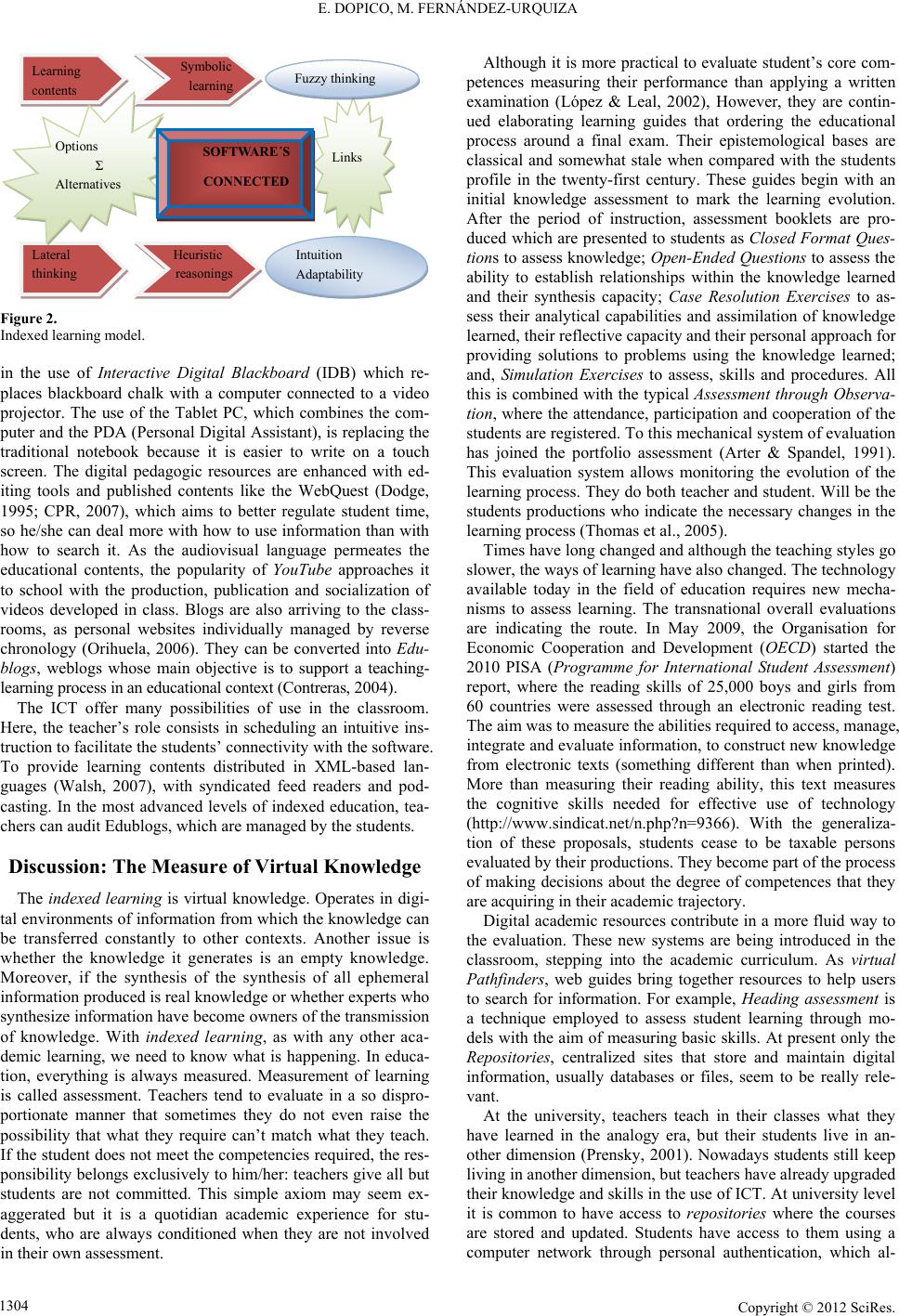 E. DOPICO, M. FERNÁNDEZ-URQUIZA Learning contents S ymbolic learning Lateral thinking Heuristic reasonings Intuition Adaptability Options Σ Alternatives Link s Fuzzy thinking SOFTWARE´S CONNECTED Figure 2. Indexed learning model. in the use of Interactive Digital Blackboard (IDB) which re- places blackboard chalk with a computer connected to a video projector. The use of the Tablet PC, which combines the com- puter and the PDA (Personal Digital Assistant), is replacing the traditional notebook because it is easier to write on a touch screen. The digital pedagogic resources are enhanced with ed- iting tools and published contents like the WebQuest (Dodge, 1995; CPR, 2007), which aims to better regulate student time, so he/she can deal more with how to use information than with how to search it. As the audiovisual language permeates the educational contents, the popularity of YouTube approaches it to school with the production, publication and socialization of videos developed in class. Blogs are also arriving to the class- rooms, as personal websites individually managed by reverse chronology (Orihuela, 2006). They can be converted into Edu- blogs, weblogs whose main objective is to support a teaching- learning process in an educational context (Contreras, 2004). The ICT offer many possibilities of use in the classroom. Here, the teacher’s role consists in scheduling an intuitive ins- truction to facilitate the students’ connectivity with the software. To provide learning contents distributed in XML-based lan- guages (Walsh, 2007), with syndicated feed readers and pod- casting. In the most advanced levels of indexed education, tea- chers can audit Edublogs, which are managed by the students. Discussion: The Measure of Virtual Knowledge The indexed learning is virtual knowledge. Operates in digi- tal environments of information from which the knowledge can be transferred constantly to other contexts. Another issue is whether the knowledge it generates is an empty knowledge. Moreover, if the synthesis of the synthesis of all ephemeral information produced is real knowledge or whether experts who synthesize information have become owners of the transmission of knowledge. With indexed learning, as with any other aca- demic learning, we need to know what is happening. In educa- tion, everything is always measured. Measurement of learning is called assessment. Teachers tend to evaluate in a so dispro- portionate manner that sometimes they do not even raise the possibility that what they require can’t match what they teach. If the student does not meet the competencies required, the res- ponsibility belongs exclusively to him/her: teachers give all but students are not committed. This simple axiom may seem ex- aggerated but it is a quotidian academic experience for stu- dents, who are always conditioned when they are not involved in their own assessment. Although it is more practical to evaluate student’s core com- petences measuring their performance than applying a written examination (López & Leal, 2002), However, they are contin- ued elaborating learning guides that ordering the educational process around a final exam. Their epistemological bases are classical and somewhat stale when compared with the students profile in the twenty-first century. These guides begin with an initial knowledge assessment to mark the learning evolution. After the period of instruction, assessment booklets are pro- duced which are presented to students as Closed Format Ques- tions to assess knowledge; Open-Ended Questions to assess the ability to establish relationships within the knowledge learned and their synthesis capacity; Case Resolution Exercises to as- sess their analytical capabilities and assimilation of knowledge learned, their reflective capacity and their personal approach for providing solutions to problems using the knowledge learned; and, Simulation Exercises to assess, skills and procedures. All this is combined with the typical Assessment through Observa- tion, where the attendance, participation and cooperation of the students are registered. To this mechanical system of evaluation has joined the portfolio assessment (Arter & Spandel, 1991). This evaluation system allows monitoring the evolution of the learning process. They do both teacher and student. Will be the students productions who indicate the necessary changes in the learning process (Thomas et al., 2005). Times have long changed and although the teaching styles go slower, the ways of learning have also changed. The technology available today in the field of education requires new mecha- nisms to assess learning. The transnational overall evaluations are indicating the route. In May 2009, the Organisation for Economic Cooperation and Development (OECD) started the 2010 PISA (Programme for International Student Assessment) report, where the reading skills of 25,000 boys and girls from 60 countries were assessed through an electronic reading test. The aim was to measure the abilities required to access, manage, integrate and evaluate information, to construct new knowledge from electronic texts (something different than when printed). More than measuring their reading ability, this text measures the cognitive skills needed for effective use of technology (http://www.sindicat.net/n.php?n=9366). With the generaliza- tion of these proposals, students cease to be taxable persons evaluated by their productions. They become part of the process of making decisions about the degree of competences that they are acquiring in their academic trajectory. Digital academic resources contribute in a more fluid way to the evaluation. These new systems are being introduced in the classroom, stepping into the academic curriculum. As virtual Pathfinders, web guides bring together resources to help users to search for information. For example, Heading assessment is a technique employed to assess student learning through mo- dels with the aim of measuring basic skills. At present only the Repositories, centralized sites that store and maintain digital information, usually databases or files, seem to be really rele- vant. At the university, teachers teach in their classes what they have learned in the analogy era, but their students live in an- other dimension (Prensky, 2001). Nowadays students still keep living in another dimension, but teachers have already upgraded their knowledge and skills in the use of ICT. At university level it is common to have access to repositories where the courses are stored and updated. Students have access to them using a computer network through personal authentication, which al- Copyright © 2012 SciRes. 1304 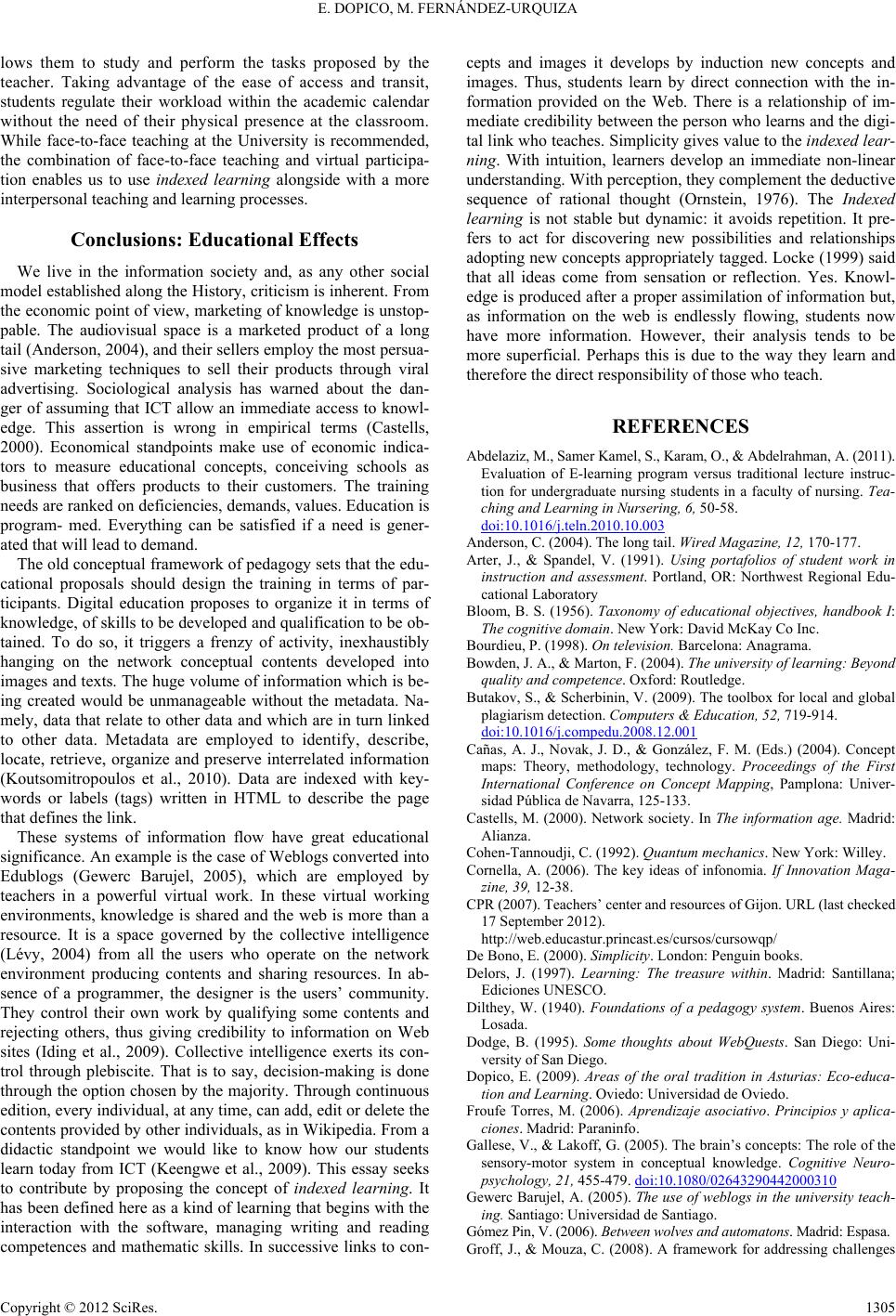 E. DOPICO, M. FERNÁNDEZ-URQUIZA lows them to study and perform the tasks proposed by the teacher. Taking advantage of the ease of access and transit, students regulate their workload within the academic calendar without the need of their physical presence at the classroom. While face-to-face teaching at the University is recommended, the combination of face-to-face teaching and virtual participa- tion enables us to use indexed learning alongside with a more interpersonal teaching and learning processes. Conclusions: Educational Effects We live in the information society and, as any other social model established along the History, criticism is inherent. From the economic point of view, marketing of knowledge is unstop- pable. The audiovisual space is a marketed product of a long tail (Anderson, 2004), and their sellers employ the most persua- sive marketing techniques to sell their products through viral advertising. Sociological analysis has warned about the dan- ger of assuming that ICT allow an immediate access to knowl- edge. This assertion is wrong in empirical terms (Castells, 2000). Economical standpoints make use of economic indica- tors to measure educational concepts, conceiving schools as business that offers products to their customers. The training needs are ranked on deficiencies, demands, values. Education is program- med. Everything can be satisfied if a need is gener- ated that will lead to demand. The old conceptual framework of pedagogy sets that the edu- cational proposals should design the training in terms of par- ticipants. Digital education proposes to organize it in terms of knowledge, of skills to be developed and qualification to be ob- tained. To do so, it triggers a frenzy of activity, inexhaustibly hanging on the network conceptual contents developed into images and texts. The huge volume of information which is be- ing created would be unmanageable without the metadata. Na- mely, data that relate to other data and which are in turn linked to other data. Metadata are employed to identify, describe, locate, retrieve, organize and preserve interrelated information (Koutsomitropoulos et al., 2010). Data are indexed with key- words or labels (tags) written in HTML to describe the page that defines the link. These systems of information flow have great educational significance. An example is the case of Weblogs converted into Edublogs (Gewerc Barujel, 2005), which are employed by teachers in a powerful virtual work. In these virtual working environments, knowledge is shared and the web is more than a resource. It is a space governed by the collective intelligence (Lévy, 2004) from all the users who operate on the network environment producing contents and sharing resources. In ab- sence of a programmer, the designer is the users’ community. They control their own work by qualifying some contents and rejecting others, thus giving credibility to information on Web sites (Iding et al., 2009). Collective intelligence exerts its con- trol through plebiscite. That is to say, decision-making is done through the option chosen by the majority. Through continuous edition, every individual, at any time, can add, edit or delete the contents provided by other individuals, as in Wikipedia. From a didactic standpoint we would like to know how our students learn today from ICT (Keengwe et al., 2009). This essay seeks to contribute by proposing the concept of indexed learning. It has been defined here as a kind of learning that begins with the interaction with the software, managing writing and reading competences and mathematic skills. In successive links to con- cepts and images it develops by induction new concepts and images. Thus, students learn by direct connection with the in- formation provided on the Web. There is a relationship of im- mediate credibility between the person who learns and the digi- tal link who teaches. Simplicity gives value to the indexed lear- ning. With intuition, learners develop an immediate non-linear understanding. With perception, they complement the deductive sequence of rational thought (Ornstein, 1976). The Indexed learning is not stable but dynamic: it avoids repetition. It pre- fers to act for discovering new possibilities and relationships adopting new concepts appropriately tagged. Locke (1999) said that all ideas come from sensation or reflection. Yes. Knowl- edge is produced after a proper assimilation of information but, as information on the web is endlessly flowing, students now have more information. However, their analysis tends to be more superficial. Perhaps this is due to the way they learn and therefore the direct responsibility of those who teach. REFERENCES Abdelaziz, M., Samer Kamel, S., Karam, O., & Abdelrahman, A. (2011). Evaluation of E-learning program versus traditional lecture instruc- tion for undergraduate nursing students in a faculty of nursing. Tea- ching and Learning in Nursering, 6, 50-58. doi:10.1016/j.teln.2010.10.003 Anderson, C. (2004). The long tail. Wired Magazine, 12, 170-177. Arter, J., & Spandel, V. (1991). Using portafolios of student work in instruction and assessment. Portland, OR: Northwest Regional Edu- cational Laboratory Bloom, B. S. (1956). Taxonomy of educational objectives, handbook I: The cognitive domain. New York: David McKay Co Inc. Bourdieu, P. (1998). On television. Barcelona: Anagrama. Bowden, J. A., & Marton, F. (2004). The university of learning: Beyond quality and competence. Oxford: Routledge. Butakov, S., & Scherbinin, V. (2009). The toolbox for local and global plagiarism detection. Computers & Education, 52, 719-914. doi:10.1016/j.compedu.2008.12.001 Cañas, A. J., Novak, J. D., & González, F. M. (Eds.) (2004). Concept maps: Theory, methodology, technology. Proceedings of the First International Conference on Concept Mapping, Pamplona: Univer- sidad Pública de Navarra, 125-133. Castells, M. (2000). Network society. In The information age. Madrid: Alianza. Cohen-Tannoudji, C. (1992). Quantum mechanics. New York: Willey. Cornella, A. (2006). The key ideas of infonomia. If Innovation Maga- zine, 39, 12-38. CPR (2007). Teachers’ center and resources of Gijon. URL (last checked 17 September 2012). http://web.educastur.princast.es/cursos/cursowqp/ De Bono, E. (2000). Simplicity. London: Penguin books. Delors, J. (1997). Learning: The treasure within. Madrid: Santillana; Ediciones UNESCO. Dilthey, W. (1940). Foundations of a pedagogy system. Buenos Aires: Losada. Dodge, B. (1995). Some thoughts about WebQuests. San Diego: Uni- versity of San Diego. Dopico, E. (2009). Areas of the oral tradition in Asturias: Eco-educa- tion and Learning. Oviedo: Universidad de Oviedo. Froufe Torres, M. (2006). Aprendizaje asociativo. Principios y aplica- ciones. Madrid: Paraninfo. Gallese, V., & Lakoff, G. (2005). The brain’s concepts: The role of the sensory-motor system in conceptual knowledge. Cognitive Neuro- psychology, 21, 455-479. doi:10.1080/02643290442000310 Gewerc Barujel, A. (2005). The use of weblogs in the university teach- ing. Santiago: Universidad de Santiago. Gómez Pin, V. (2006). Between wolves and automatons. Madrid: Espasa. Groff, J., & Mouza, C. (2008). A framework for addressing challenges Copyright © 2012 SciRes. 1305 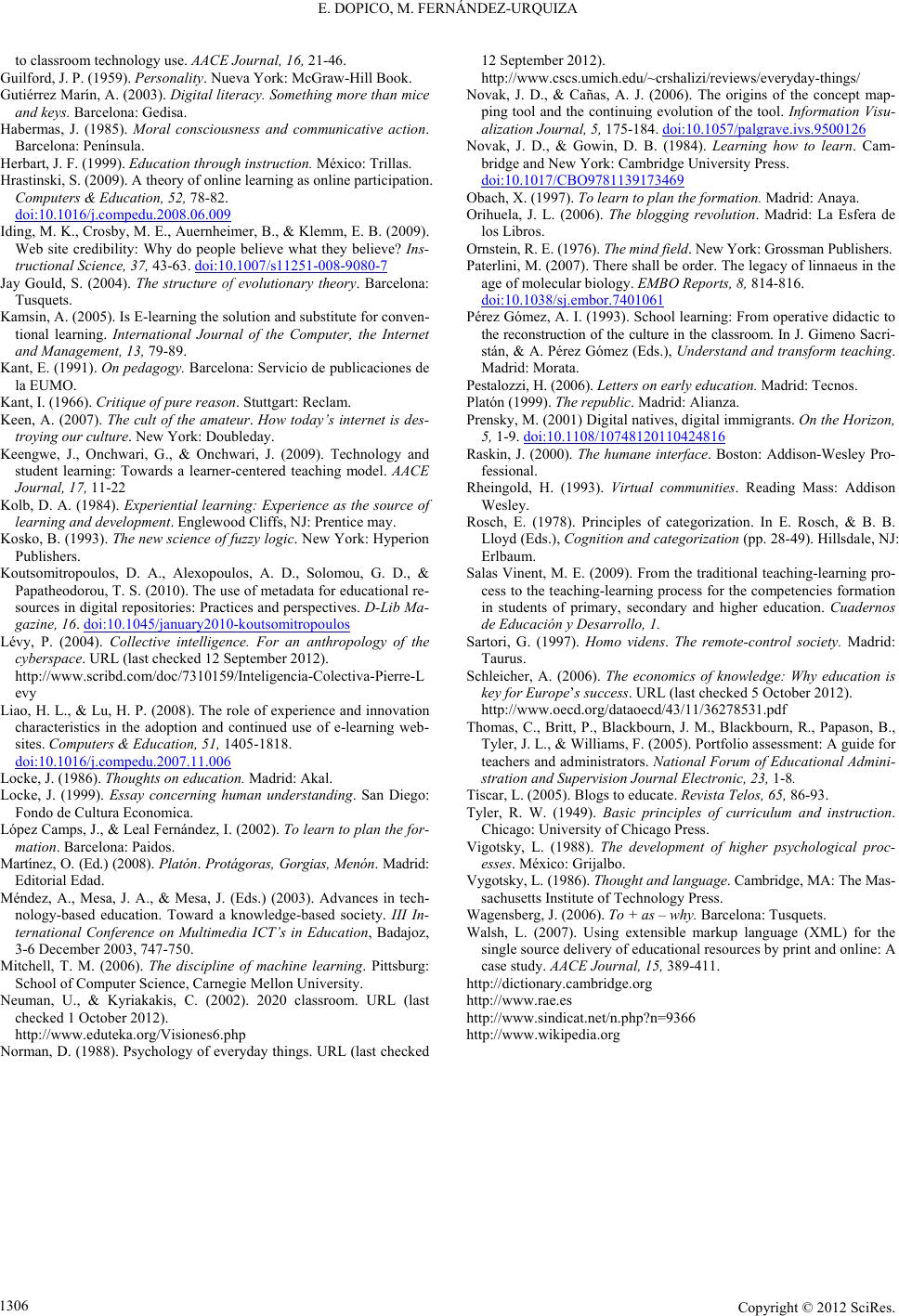 E. DOPICO, M. FERNÁNDEZ-URQUIZA Copyright © 2012 SciRes. 1306 to classroom technology use. AACE Journal, 16, 21-46. Guilford, J. P. (1959). Personality. Nueva York: McGraw-Hill Book. Gutiérrez Marín, A. (2003). Digital literacy. Something more than mice and keys. Barcelona: Gedisa. Habermas, J. (1985). Moral consciousness and communicative action. Barcelona: Península. Herbart, J. F. (1999). Education through instruction. México: Trillas. Hrastinski, S. (2009). A theory of online learning as online participation. Computers & Education, 52, 78-82. doi:10.1016/j.compedu.2008.06.009 Iding, M. K., Crosby, M. E., Auernheimer, B., & Klemm, E. B. (2009). Web site credibility: Why do people believe what they believe? Ins- tructional Science, 37, 43-63. doi:10.1007/s11251-008-9080-7 Jay Gould, S. (2004). The structure of evolutionary theory. Barcelona: Tusquets. Kamsin, A. (2005). Is E-learning the solution and substitute for conven- tional learning. International Journal of the Computer, the Internet and Management, 13, 79-89. Kant, E. (1991). On pedagogy. Barcelona: Servicio de publicaciones de la EUMO. Kant, I. (1966). Critique of pure reason. Stuttgart: Reclam. Keen, A. (2007). The cult of the amateur. How today’s internet is des- troying our culture. New York: Doubleday. Keengwe, J., Onchwari, G., & Onchwari, J. (2009). Technology and student learning: Towards a learner-centered teaching model. AACE Journal, 17, 11-22 Kolb, D. A. (1984). Experiential learning: Experience as the source of learning and development. Englewood Cliffs, NJ: Prentice may. Kosko, B. (1993). The new science of fuzzy logic. New York: Hyperion Publishers. Koutsomitropoulos, D. A., Alexopoulos, A. D., Solomou, G. D., & Papatheodorou, T. S. (2010). The use of metadata for educational re- sources in digital repositories: Practices and perspectives. D-Lib Ma- gazine, 16. doi:10.1045/january2010-koutsomitropoulos Lévy, P. (2004). Collective intelligence. For an anthropology of the cyberspace. URL (last checked 12 September 2012). http://www.scribd.com/doc/7310159/Inteligencia-Colectiva-Pierre-L evy Liao, H. L., & Lu, H. P. (2008). The role of experience and innovation characteristics in the adoption and continued use of e-learning web- sites. Computers & Education, 51, 1405-1818. doi:10.1016/j.compedu.2007.11.006 Locke, J. (1986). Thoughts on education. Madrid: Akal. Locke, J. (1999). Essay concerning human understanding. San Diego: Fondo de Cultura Economica. López Camps, J., & Leal Fernández, I. (2002). To learn to plan the for- mation. Barcelona: Paidos. Martínez, O. (Ed.) (2008). Platón. Protágoras, Gorgias, Menón. Madrid: Editorial Edad. Méndez, A., Mesa, J. A., & Mesa, J. (Eds.) (2003). Advances in tech- nology-based education. Toward a knowledge-based society. III In- ternational Conference on Multimedia ICT’s in Education, Badajoz, 3-6 December 2003, 747-750. Mitchell, T. M. (2006). The discipline of machine learning. Pittsburg: School of Computer Science, Carnegie Mellon University. Neuman, U., & Kyriakakis, C. (2002). 2020 classroom. URL (last checked 1 October 2012). http://www.eduteka.org/Visiones6.php Norman, D. (1988). Psychology of everyday things. URL (last checked 12 September 2012). http://www.cscs.umich.edu/~crshalizi/reviews/everyday-things/ Novak, J. D., & Cañas, A. J. (2006). The origins of the concept map- ping tool and the continuing evolution of the tool. Information Visu- alization Journal, 5, 175-184. doi:10.1057/palgrave.ivs.9500126 Novak, J. D., & Gowin, D. B. (1984). Learning how to learn. Cam- bridge and New York: Cambridge University Press. doi:10.1017/CBO9781139173469 Obach, X. (1997). To learn to plan the formation. Madrid: Anaya. Orihuela, J. L. (2006). The blogging revolution. Madrid: La Esfera de los Libros. Ornstein, R. E. (1976). The mind field. New York: Grossman Publishers. Paterlini, M. (2007). There shall be order. The legacy of linnaeus in the age of molecular biology. EMBO Reports, 8, 814-816. doi:10.1038/sj.embor.7401061 Pérez Gómez, A. I. (1993). School learning: From operative didactic to the reconstruction of the culture in the classroom. In J. Gimeno Sacri- stán, & A. Pérez Gómez (Eds.), Un derstand and transform teaching. Madrid: Morata. Pestalozzi, H. (2006). Letters on early education. Madrid: Tecnos. Platón (1999). The republic. Madrid: Alianza. Prensky, M. (2001) Digital natives, digital immigrants. On the Horizon, 5, 1-9. doi:10.1108/10748120110424816 Raskin, J. (2000). The humane interface. Boston: Addison-Wesley Pro- fessional. Rheingold, H. (1993). Virtual communities. Reading Mass: Addison Wesley. Rosch, E. (1978). Principles of categorization. In E. Rosch, & B. B. Lloyd (Eds.), Cognition and categorization (pp. 28-49). Hillsdale, NJ: Erlbaum. Salas Vinent, M. E. (2009). From the traditional teaching-learning pro- cess to the teaching-learning process for the competencies formation in students of primary, secondary and higher education. Cuadernos de Educación y Desarrollo, 1. Sartori, G. (1997). Homo videns. The remote-control society. Madrid: Taurus. Schleicher, A. (2006). The economics of knowledge: Why education is key for Europe’s success. URL (last checked 5 October 2012). http://www.oecd.org/dataoecd/43/11/36278531.pdf Thomas, C., Britt, P., Blackbourn, J. M., Blackbourn, R., Papason, B., Tyler, J. L., & Williams, F. (2005). Portfolio assessment: A guide for teachers and administrators. National Forum of Educational Admini- stration and Supervision Journal Electronic, 23, 1-8. Tíscar, L. (2005). Blogs to educate. Revista Telos, 65, 86-93. Tyler, R. W. (1949). Basic principles of curriculum and instruction. Chicago: University of Chicago Press. Vigotsky, L. (1988). The development of higher psychological proc- esses. México: Grijalbo. Vygotsky, L. (1986). Thought and language. Cambridge, MA: The Mas- sachusetts Institute of Technology Press. Wagensberg, J. (2006). T o + a s – w h y. Barcelona: Tusquets. Walsh, L. (2007). Using extensible markup language (XML) for the single source delivery of educational resources by print and online: A case study. AACE Journal, 15, 389-411. http://dictionary.cambridge.org http://www.rae.es http://www.sindicat.net/n.php?n=9366 http://www.wikipedia.org
|